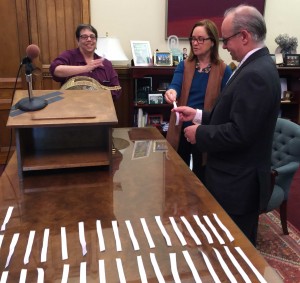About half the states, including Connecticut, have both paper ballots and post-election audits. Because our audits were transparent and publicly verifiable, Connecticut Citizen Election Audit observers have been able to reveal multiple flaws in the process and in the official reporting of audit results. Earlier this year, however, the General Assembly unanimously cut Connecticut’s the audits from 10 percent of districts to 5 percent.
Now there is more bad news: our already inadequate audits have been partially replaced by electronic “audits” which are not transparent and not publicly verifiable. Instead, we now have “black box voting” augmented by “black box auditing.” This should satisfy only those with blind trust in computers and blind trust in insiders with access to the “audit” computers.
Last week, without public notice, seven Connecticut municipalities conducted electronic “audits” under the guidance of the UConn Center for Voting Technology and the Secretary of the State’s Office, using the Audit Station developed by the Voter Center.
There is a science of election audits. Machine-assisted audits can offer efficiency and ease of use, but any audit process needs to be transparent and provide for independent public verification of the results. Machine-assisted manual audits in California and Colorado demonstrate how this can be achieved. Public verification begins with publicly rescanning the ballots and providing the public with a computer readable list of how each ballot was counted. Then selecting a small random sample of the ballots and comparing the actual voter verified ballots to the record of how the machine counted them.
It is puzzling that the UConn Voter Center, the General Assembly, and the Secretary of the State have consistently chosen to ignore the peer-reviewed science which would provide an actual audit, appropriately trusted, even faster, and even less work for local officials.
Compare existing election audits to professional audits. Professional audits include examining a sample of original documents such as receipts from vendors or signed checks. Such audits are performed by individuals independent of those accountable for doing the original job. Public verifiability is critical to post-election audits, because they are performed by those responsible for conducting the election itself, protecting the original ballots, evaluating and recommending the election equipment.
The new Connecticut system ⎯ including equipment and procedures ⎯ involves rescanning, with officials reviewing scanned images of every ballot and how it was interpreted by the system. But, scanned images are not photographs: they are as vulnerable as other computer data, subject to machine errors, tampering, and human error. Connecticut’s electronic “audits” do not verify that the ballot images correspond to the ballots. Ballots are the only evidence verified by voters.
Last week local officials reviewed each of the images for approximately one to three seconds. At that speed, it was difficult to verify that even one race of five displayed was accurately interpreted by the system. It would be more efficient, accurate, and trustworthy, to sample the paper ballots as in Colorado and California and compare them to the system interpretations.
The new system is being presented as much more economical for municipalities with less work and stress for local officials. When and if it is working properly, without errors and unhacked, it could be much more accurate than the disorganized, inconsistent hand counting that is frequently performed in Connecticut.
A solution is at hand. The UConn Audit Station is capable of providing the kind of machine-assisted manual audits that would meet the requirements of sound science for election audits. It could provide transparent, publicly verifiable audits that are independent of the software, hardware, and the officials who are responsible for the audit and the election.
Amid national concerns for election integrity and calls for stronger audits nationwide, Connecticut is positioned to be a leader in election auditing. Our manual audits were a good start, with some flaws.
The Secretary of the State and the UConn Voter Center should work with national experts to develop procedures that take full advantage of the Audit Station, to deliver efficient and trustworthy election audits. Until then our manual audits should continue. Voters and the General Assembly should insist upon transparent and publicly verifiable elections.
Luther Weeks is Executive Director of the Connecticut Citizen Election Audit.

 Drawing
Drawing Marking Map
Marking Map Complete Map
Complete Map Secretary of the State Denise Merrill selects 73 districts statewide for the post-primary audit.
Secretary of the State Denise Merrill selects 73 districts statewide for the post-primary audit.

